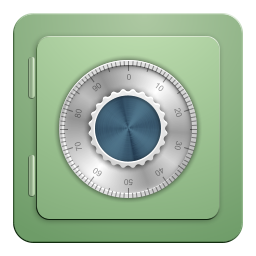Articles related to cryptography include:
FileVault is a disk encryption program in Mac OS X 10.3 Panther (2003) and later. It performs on-the-fly encryption with volumes on Mac computers.

TrueCrypt is a discontinued source-available freeware utility used for on-the-fly encryption (OTFE). It can create a virtual encrypted disk within a file, encrypt a partition, or encrypt the whole storage device.
In cryptography and steganography, plausibly deniable encryption describes encryption techniques where the existence of an encrypted file or message is deniable in the sense that an adversary cannot prove that the plaintext data exists.
Encryption software is software that uses cryptography to prevent unauthorized access to digital information. Cryptography is used to protect digital information on computers as well as the digital information that is sent to other computers over the Internet.
Disk encryption is a special case of data at rest protection when the storage medium is a sector-addressable device. This article presents cryptographic aspects of the problem. For an overview, see disk encryption. For discussion of different software packages and hardware devices devoted to this problem, see disk encryption software and disk encryption hardware.

BitLocker is a full volume encryption feature included with Microsoft Windows versions starting with Windows Vista. It is designed to protect data by providing encryption for entire volumes. By default, it uses the Advanced Encryption Standard (AES) algorithm in cipher block chaining (CBC) or "xor–encrypt–xor (XEX)-based Tweaked codebook mode with ciphertext Stealing" (XTS) mode with a 128-bit or 256-bit key. CBC is not used over the whole disk; it is applied to each individual sector.
EncFS is a Free (LGPL) FUSE-based cryptographic filesystem. It transparently encrypts files, using an arbitrary directory as storage for the encrypted files.
Steganographic file systems are a kind of file system first proposed by Ross Anderson, Roger Needham, and Adi Shamir. Their paper proposed two main methods of hiding data: in a series of fixed size files originally consisting of random bits on top of which 'vectors' could be superimposed in such a way as to allow levels of security to decrypt all lower levels but not even know of the existence of any higher levels, or an entire partition is filled with random bits and files hidden in it.

FreeOTFE is a discontinued open source computer program for on-the-fly disk encryption (OTFE). On Microsoft Windows, and Windows Mobile, it can create a virtual drive within a file or partition, to which anything written is automatically encrypted before being stored on a computer's hard or USB drive. It is similar in function to other disk encryption programs including TrueCrypt and Microsoft's BitLocker.
The Linux Unified Key Setup (LUKS) is a disk encryption specification created by Clemens Fruhwirth in 2004 and originally intended for Linux.
Disk encryption is a technology which protects information by converting it into code that cannot be deciphered easily by unauthorized people or processes. Disk encryption uses disk encryption software or hardware to encrypt every bit of data that goes on a disk or disk volume. It is used to prevent unauthorized access to data storage.

BestCrypt, developed by Jetico, is a commercial disk encryption app available for Windows, Linux, macOS and Android.
This is a technical feature comparison of different disk encryption software.
dm-crypt is a transparent block device encryption subsystem in Linux kernel versions 2.6 and later and in DragonFly BSD. It is part of the device mapper (dm) infrastructure, and uses cryptographic routines from the kernel's Crypto API. Unlike its predecessor cryptoloop, dm-crypt was designed to support advanced modes of operation, such as XTS, LRW and ESSIV, in order to avoid watermarking attacks. In addition to that, dm-crypt addresses some reliability problems of cryptoloop.
In computer security, a cold boot attack is a type of side channel attack in which an attacker with physical access to a computer performs a memory dump of a computer's random-access memory (RAM) by performing a hard reset of the target machine. Typically, cold boot attacks are used for retrieving encryption keys from a running operating system for malicious or criminal investigative reasons. The attack relies on the data remanence property of DRAM and SRAM to retrieve memory contents that remain readable in the seconds to minutes following a power switch-off.
Hardware-based full disk encryption (FDE) is available from many hard disk drive (HDD/SSD) vendors, including: Hitachi, Integral Memory, iStorage Limited, Micron, Seagate Technology, Samsung, Toshiba, Viasat UK, Western Digital. The symmetric encryption key is maintained independently from the computer's CPU, thus allowing the complete data store to be encrypted and removing computer memory as a potential attack vector.

OpenPuff Steganography and Watermarking, sometimes abbreviated OpenPuff or Puff, is a free steganography tool for Microsoft Windows created by Cosimo Oliboni and still maintained as independent software. The program is notable for being the first steganography tool that:

VeraCrypt is a free and open-source utility for on-the-fly encryption (OTFE). The software can create a virtual encrypted disk that works just like a regular disk but within a file. It can also encrypt a partition or the entire storage device with pre-boot authentication.
Apple File System (APFS) is a proprietary file system developed and deployed by Apple Inc. for macOS Sierra (10.12.4) and later, iOS 10.3, tvOS 10.2, watchOS 3.2, and all versions of iPadOS. It aims to fix core problems of HFS+, APFS's predecessor on these operating systems. APFS is optimized for solid-state drive storage and supports encryption, snapshots, and increased data integrity, among other capabilities.




